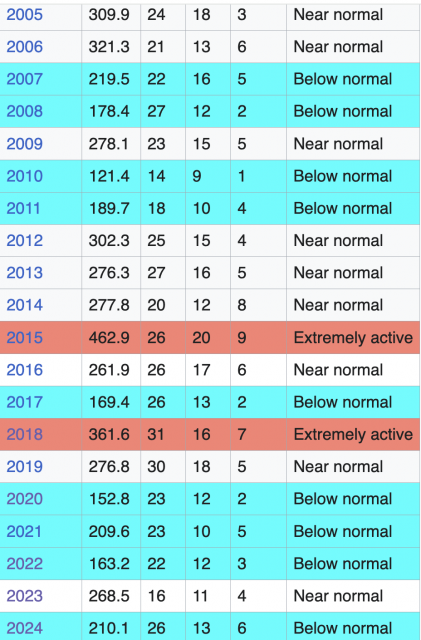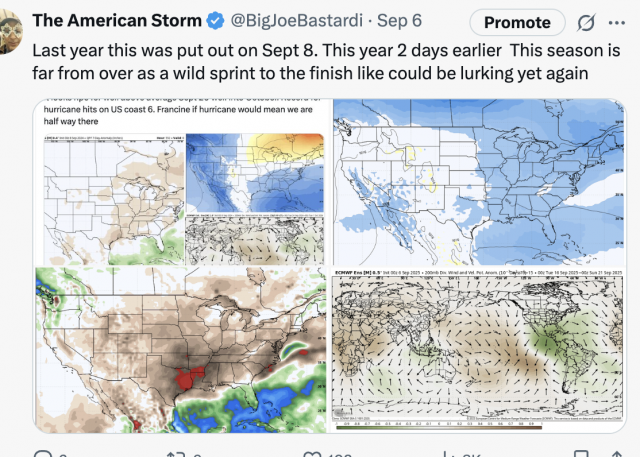In a meeting with Dr. Willie Soon, Dr. Ronan Connolly, and Dr. Michael Connolly their study on the weakening of the Hadley cell provided a compelling explanation for the 20-year downturn in the Western Pacific (WPAC), which serves as the real canary in the coal mine for tropical climate changes.
That canary is now coming home to roost in the Atlantic. While the Atlantic has been in a frenzy over the past several years as it tries to take up the slack, the distorted warming has likely impacted vertical velocity patterns over the tropics (which is what a weakening Hadley cell would imply). We now see storms developing further north, being more compact, and featuring shorter tracks. Storms like Erin are the exception, and the main development region is almost a misnomer now in both the Atlantic and the Western Pacific.
This is yet another case where what climate alarmists have been pushing is going the other way. The flurry of impacting storms on the U.S. coast gave them cover to ignore the Pacific. Yet most of these storms had much shorter tracks, exploded in intensity within two days of landfall during phase 2 of the MJO, and size-wise could not hold a candle to similar Saffir-Simpson rated storms of the past.
What is amazing to me is how, because of climate change hype, all this is being ignored.
- The Western Pacific with lower ACE, lower ACE per storm, and a shift north of development areas compared to the 1950s.
- The need for the Saffir-Simpson scale to be replaced by a scale like WeatherBELL’s, where size matters as much as peak wind speed near the center—something even the Hurricane Center has admitted (size matters).
Both of these have plenty to do with stopping all the nonsense we’ve heard in past years about storms getting worse. Because if we can line up all the storms by comparing the Saffir-Simpson rating against the more extensive and descriptive power and impact scale—which takes into account the extent of 64, 50, and 34 kt winds, as well as sudden increases or decreases in pressure—we get a much better look at where we stand versus other years.
As for the Western Pacific, if you’ve been following me, I’ve been pointing this out as a counter to the climate hysteria. They spout all this nonsense about things getting worse—yet globally, when the areas that produce 60% of the Northern Hemisphere ACE are way down (this year could be a record low), you don’t hear a peep. They love it when a storm goes in and causes major damage, either ignorant of the fact that it’s a way of life, or common in that part of the world. They average 8 or 9 super typhoons a year, and if one shows up, it’s a gawking show. This year, by the way, none so far.
I don’t think the Atlantic basin is done, and I believe we are likely to see a 2-3 week flurry of development (in fact, last year, the “Attention Gov. Desantis and SE governors” tweet was issued Sept 8, on Sept 6 I put this out)
with enough impact to reach the bottom end of our impact ranges in our forecast. That has always been where I’ve been steering the discussion here—not storms in the middle of nowhere. But that being said, it’s likely that the distorted warming, along with the rapid drop-off in SST and WV as we shake off Tonga, is having a big impact on the Atlantic as well, as it’s a sign of a lot of sinking air over the tropics relative to averages. Like I said, it’s been going on in the Pacific, but it’s convenient that it’s ignored. And for a crowd that is so concerned about global this and global that, ignoring one of the largest signals of what’s actually happening confirms what I wrote about here:
That’s the way they push this—with deception, distortion, and delusion.
But just remember, what we are seeing in the Atlantic now has been happening in the basin. That is far more important if one is going to try to claim global climate links, the Western Pacific. And like so many of the pronouncements of a climate cabal that should be held accountable.
https://www.cfact.org/2025/07/05/it-is-time-to-hold-the-climate-cabal-accountable/


